Dual Discoveries
A sampling from two decades of mind-blowing Emory-Tech innovation and inventions

Gary Meek/Georgia Tech
Sizing Up Seizures
When groups of nerve cells in the brain fire too often and at random—what people with epilepsy sometimes call "brain lightning" or "an electrical storm in my brain"—seizures can be the result. From using electrodes to excite neurons in an epileptic rat model to stimulating the optic nerve with light, neuroengineer Steve Potter of the Coulter Department of Biomedical Engineering at Georgia Tech and Emory, and Bob Gross of Emory School of Medicine's Department of Neurosurgery are developing brain stimulation therapies that could help people with epilepsy who don't respond to drugs. "We want to better understand what causes epileptic seizures and try to find a way to respond to those bursts in activity with stimulation and reduce the number of seizures an individual experiences," Potter says.

Courtesy Zoo Atlanta
Gorilla Tough Cuff
Responding to a plea from Zoo Atlanta, a team of Coulter students and faculty successfully created the world's first-ever blood pressure cuff to be used on a gorilla not under anesthesia. The device was successfully tested on one of Zoo Atlanta's western lowland gorillas—Ozzie, a forty-eight-year-old male. Cardiac disease is the leading cause of mortality in adult male gorillas living in captivity.
Multiple Exposures
Over a lifetime, you are exposed to hundreds of environmental pollutants, chemicals, and toxins—from household cleaners to medications to food. Their collective impact results in your exposome—the environmental equivalent of the individual human genome. How these exposures interact with your individual genetics, physiology, and other stressors is the focus of HERCULES (Health and Exposome Research Center: Understanding Lifetime Exposures) at Rollins School of Public Health, which includes nearly forty investigators from Emory and Georgia Tech. "The exposome represents all of the external forces that act upon us," says Gary Miller, professor and associate dean for research at Rollins and director of HERCULES.
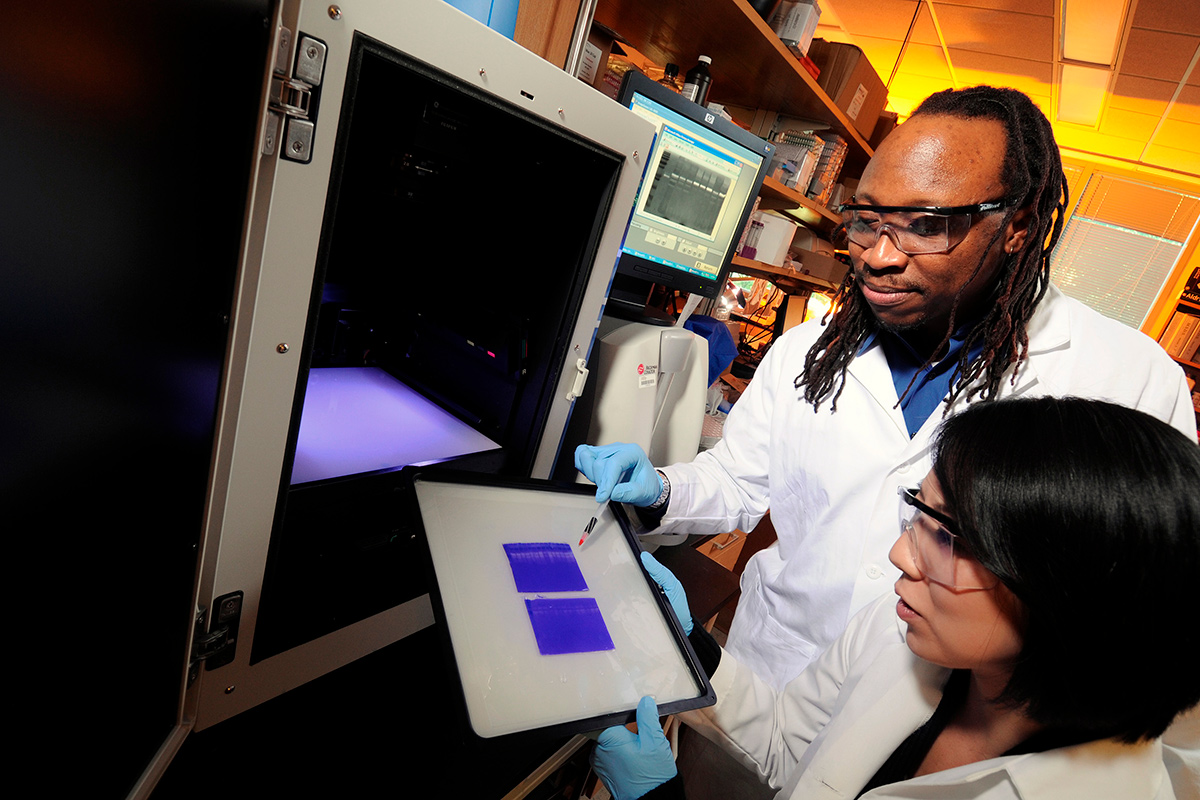
Manu Platt, left, with fellow researcher Keon-Young Park 08C 18PhD
Gary Meek/Georgia Tech
HIV and the Heart
Coulter Assistant Professors Manu Platt and Rudy Gleason are collaborating with Associate Professor Roy Sutliff of Emory and the Atlanta VA Medical Center to study early onset cardiovascular disease with HIV infection. By making a tissue-engineered artery composed of human cells that can be infected with HIV, the researchers hope their findings will eventually help discern the role of antiretroviral therapy in cardiovascular disease. "Our hypothesis is that HIV infection and shedding of its proteins exacerbates the cardiovascular disease already caused by disturbed blood flow and altered biomechanics," Platt says. "The experimental systems we develop will allow for studying these effects in a controlled fashion using the human virus infection of human cells, not human patients."
Painless Vaccine

Gary Meek/Georgia Tech
Flu vaccines delivered through skin patches with dissolvable microneedles have proven more effective in mice than traditional flu shots, according to Richard Compans, professor of microbiology and immunology in Emory's School of Medicine; Mark Prausnitz, professor in the Georgia Tech School of Chemical and Biomolecular Engineering; and other Emory and Georgia Tech colleagues on the microneedle research teams. "Potentially, individuals could administer the vaccine to themselves, perhaps after receiving it in the mail," Compans says. The patches could be stored for extended periods of time at room temperature and could require smaller amounts of vaccine, which would greatly expand immunization programs in developing countries and reduce disease transmission from the reuse of conventional needles.
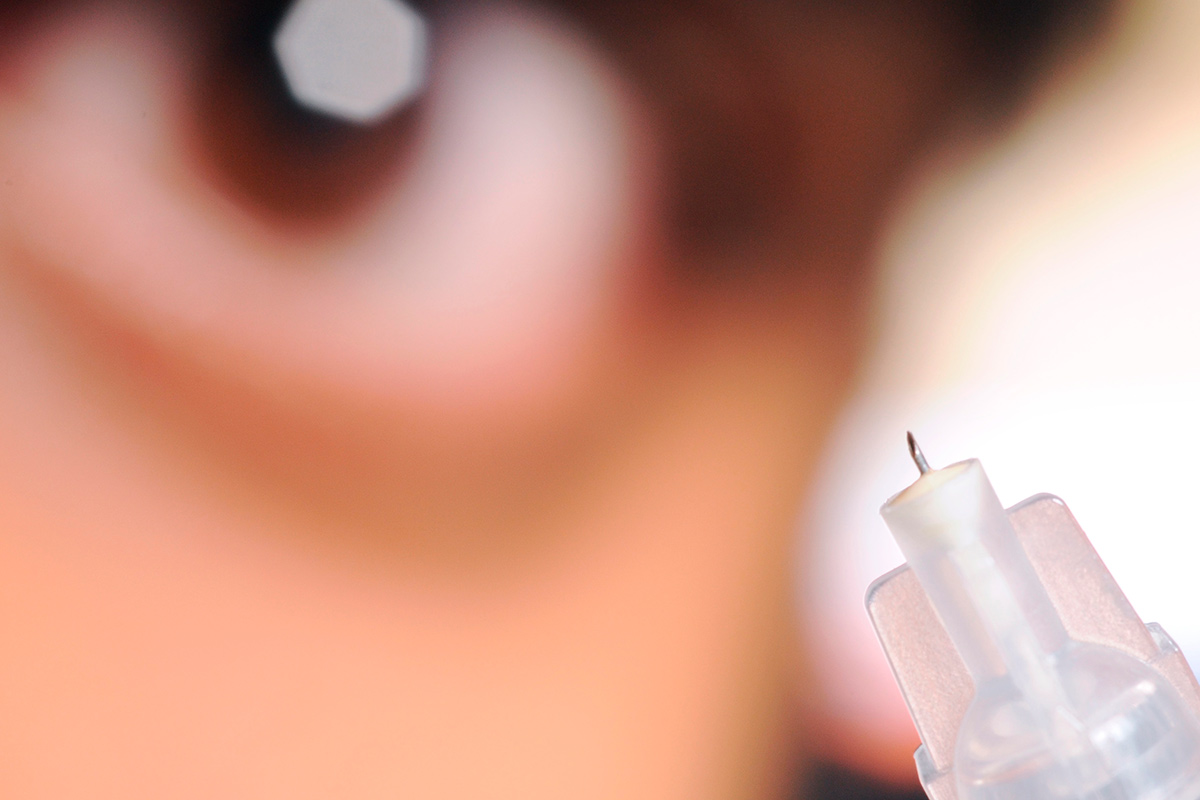
Gary Meek/Georgia Tech
A (micro)needle in your eye
For diseases such as macular degeneration or uveitis, medication must be delivered to the back of the eye with a needle. Henry Edelhauser, professor of ophthalmology at Emory's School of Medicine, and Mark Prausnitz, professor of chemical and biomedical engineering at Georgia Tech, have invented a hollow-tubed microneedle that allows for more precision. "The microneedle is about as long as a regular hypodermic needle is wide," says Prausnitz. "It enables us to reach specific places in the eye—exactly where the medication needs to be." Edelhauser and Prausnitz are scientific founders of Clearside Biomedical, a start-up ophthalmology pharmaceutical that is developing ocular microinjection technology.
Pay Close Attention

Michael Ammons/USAF
Air traffic controllers, military analysts, doctors, pilots, prison guards, and their professional ilk must remain alert and focused, sometimes for extended periods, even late into the night. Assistant Professor Shella Keilholz of the Coulter Department of Biomedical Engineering is principal investigator of the Magnetic Resonance Imaging of Neural Dynamics (MIND) lab, where researchers are using an MRI to map the connectivity of the brain while an individual performs a task that requires vigilance. Initial results show that the level of brain activity preceding the presentation of a visual stimulus can predict how fast the person will respond. "We are trying to develop a noninvasive way to measure the current state of an individual's brain and determine if that person is getting off task," says Keilholz.
Call IT
With advances in medical imaging—such as digital pathology, which focuses on automating the detection and diagnosis of cancer and other diseases through advanced processing of large sets of image data—comes a need for advanced information technologies (IT). The Institute for Data and High Performance Computing is fostering cooperation among Georgia Tech researchers and Emory's Center for Comprehensive Informatics, led by Rollins School of Public Health Professor of Biostatistics Lance Waller. Standardization is vital since radiology and pathology images are used as key components of baseline disease classification; images are also increasingly used as biomarkers to assess treatment response.
Without Missing a Beat
If cardiac surgery can be performed on a beating heart through a small incision, it reduces bleeding, risk of infection, and the stress of stopping and restarting the heart. The start-up Apica Cardiovascular has licensed a Georgia Tech/Emory technology invented by researchers Ajit Yoganathan, Jorge Jimenez, Thomas Vassiliades, and Vinod Thourani to simplify and standardize this technique. With support from the Coulter Foundation Translational Research Program and the Georgia Research Alliance VentureLab program, the company has completed preclinical studies. "By minimizing the incision size to gain access to the beating heart and eliminating the need for conventional sutures, our system improves safety, decreases procedure time, and reduces some technical challenges," says Thourani, associate professor of surgery and codirector of the Structural Heart Center in Emory's Division of Cardiothoracic Surgery. The company was named Emory University's Start-up Company of 2010.
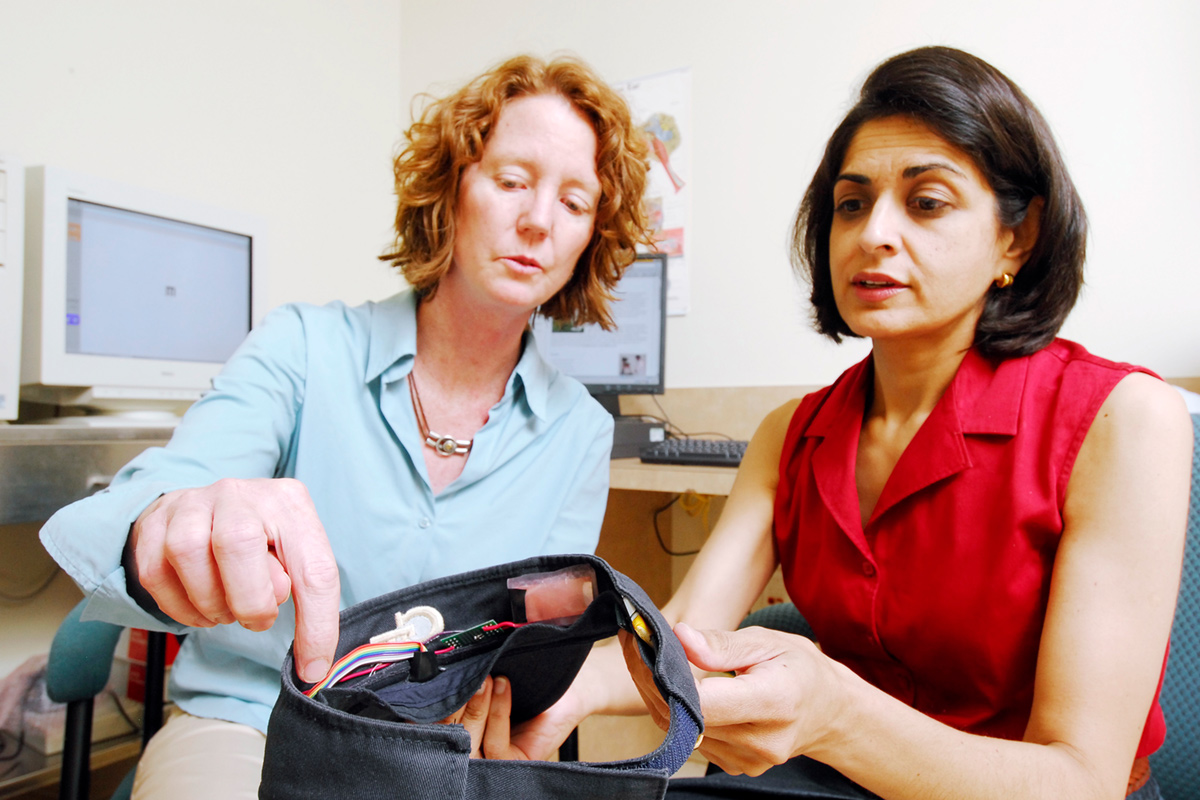
Pamela Bhatti, right, with fellow researcher
Gary Meek/Georgia Tech
Balancing Act
Using inexpensive gyroscopes embedded in a visor, Pamela Bhatti, assistant professor of electrical and computer engineering at Georgia Tech and a KL2 scholar with the Atlanta Clinical and Translational Science Institute led by Emory, is working on a system to monitor patients automatically during in-home rehabilitation. Vestibular exercises can improve balance; reduce dizziness, disorientation, and blurred vision during head movements; and prevent falls. Bhatti's head angular motion-monitoring system (HAMMS) uses microelectronics and motion sensors to capture head rotations during exercises. HAMMS also will serve as a data-logging tool to study the execution of in-home exercises by patients in the Emory Dizziness and Balance Center.

Courtesy the Office of Technology Transfer
We got it all
A handheld spectroscopic device to improve the accuracy of cancer surgery, the SpectroPen, was invented by Shuming Nie, the Coulter Distinguished Faculty Chair in Biomedical Engineering and director of the cancer nanotechnology programs at Emory's Winship Cancer Institute. The SpectroPen detects fluorescent dyes and miniscule light-reflecting gold particles (also invented by Nie) that stick to cancer cells. "It helps surgeons see the edges of a tumor so they can more reliably remove all of it," Nie says. The SpectroPen, which was named a top medical innovation of 2010 by the Georgia Research Alliance, is in human clinical trials.
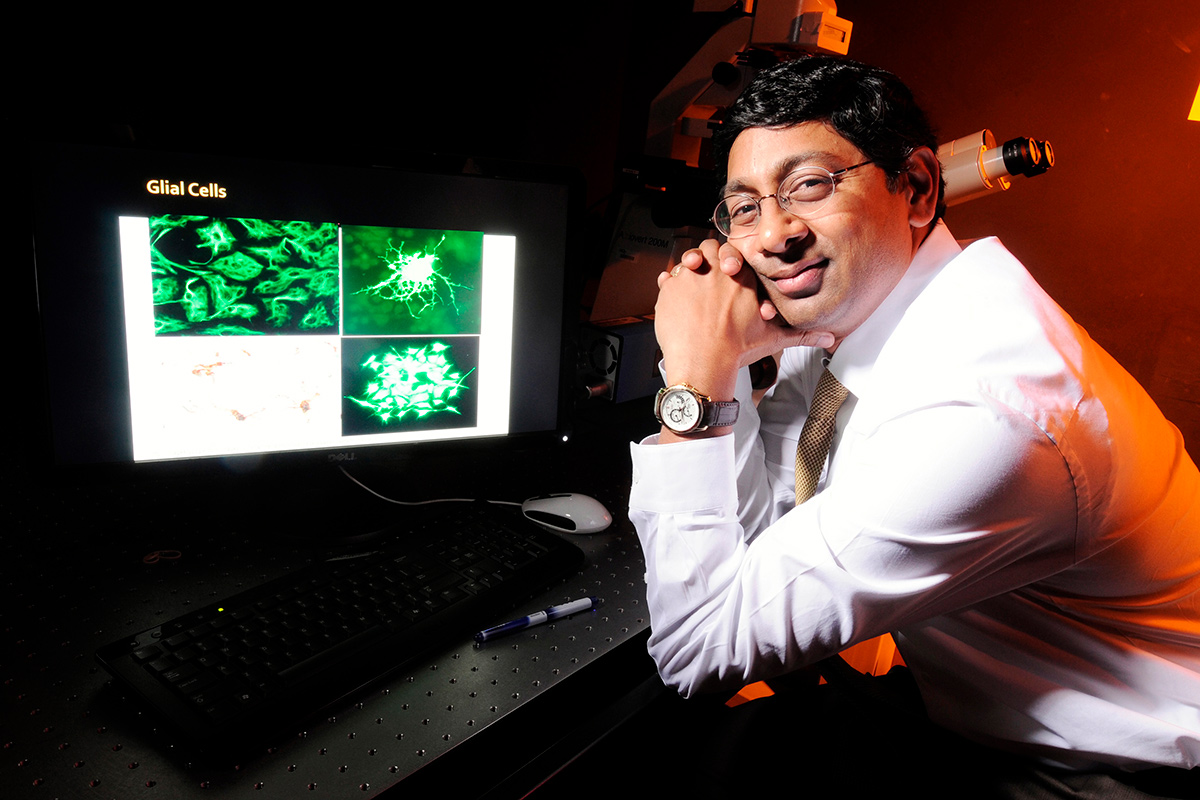
Ravi Bellamkonda
Gary Meek/Georgia Tech
Tumor Target
Tumors that burrow deep into healthy brain tissue are hard to treat, whether with surgery, chemotherapy, or radiation. Emory dermatologist Jack Arbiser and Coulter's Ravi Bellamkonda have designed a new treatment that appears to halt the spread of cancer cells into normal brain tissue in animal models. The researchers treated rats with an invasive tumor with a compound called imipramine blue, followed by conventional chemotherapy. The tumors stopped their invasion of healthy tissue, and the animals survived longer than animals treated with chemotherapy alone.
That Hits the Spot
In radiation therapy, precision is the name of the game. Intensity-modulated radiation therapy (IMRT) uses computer-controlled linear accelerators to deliver therapeutic doses to tumors while avoiding critical organs, says Professor Shabbir Ahmed, of the Stewart School of Industrial and Systems Engineering at Georgia Tech. Ahmed worked with Georgia Tech Industrial and Systems Engineering Professor Martin Savelsbergh, and Ian Crocker, Timothy Fox, and Eduard Schreibmann from Emory's Department of Radiation Oncology.
High Alert
Smallpox. Sarin gas. Explosive residue. The ability to detect pathogens, biological agents, and dangerous chemicals at minute levels might make the difference between life and death for thousands in the event of a terrorist attack. A new class of sensors able to pick up on multiple biological and chemical threats simultaneously with unprecedented accuracy has been invented by Georgia Tech and Emory researchers through a Department of Defense Center in Integrated Photonics Engineering Research (CIPhER). "The proposed sensors are faster, less expensive, and more sensitive," says Georgia Tech Pettit Professor of Electronics Ali Adibi, who partnered with Emory's Timmie Professor of Biochemistry Richard Cummings.

May Dongmei Wang
Gary Meek/Georgia Tech
Personalized Biomarkers
In this dawning era of molecular medicine, cancer detection and treatment will increasingly be tailored to each individual's molecular profile. This personalized approach is enabled by research that discovers and links biomarkers—such as genes or proteins—to specific disease behaviors. May Dongmei Wang and her team in the Coulter Department are working with physicians at Emory and Children's Healthcare of Atlanta to develop informatics systems for personalized health, including caCORRECT and omniBiomarker, which remove noise and artifacts, and identify and validate biomarkers.
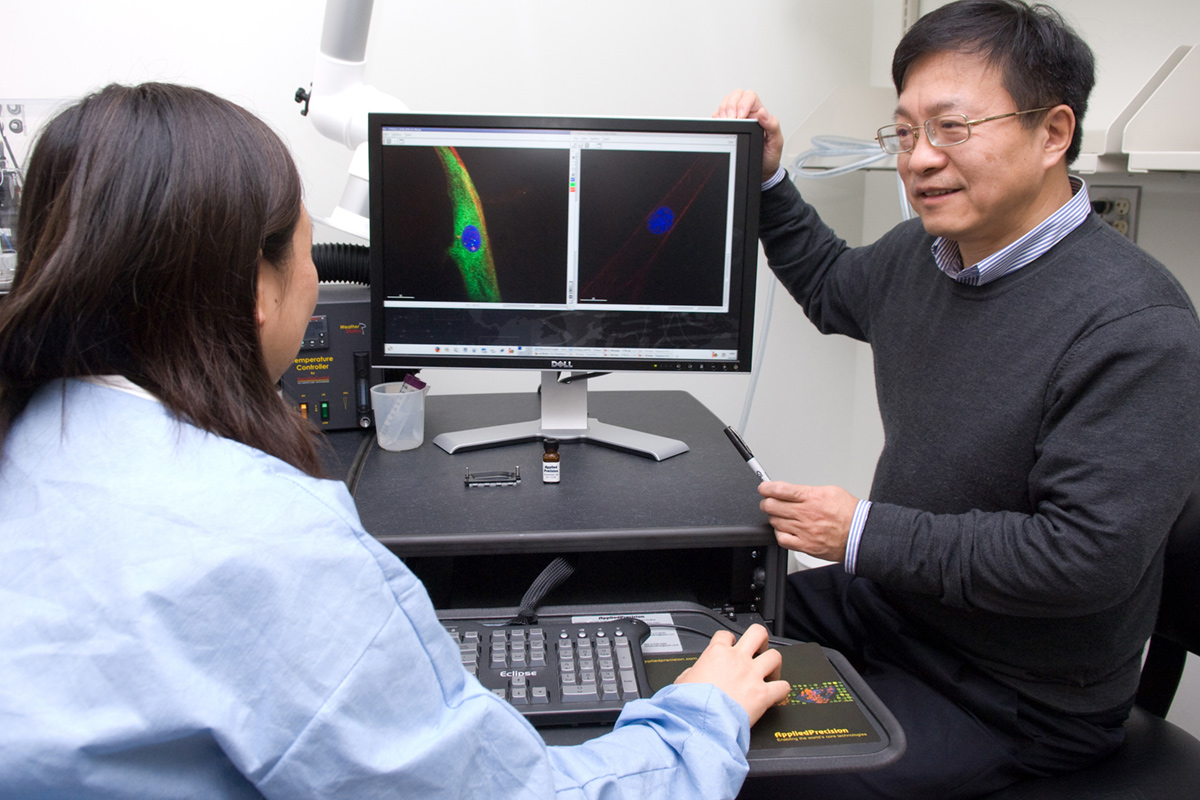
Gang Bao, right, with fellow researcher
Rob Felt/Georgia Tech
Genetic Do-Over
Sickle cell disease involves a single altered gene that produces abnormal hemoglobin, the protein that carries oxygen in the blood. Red blood cells become hard, sticky, "C"-shaped sickle cells, which die early, causing a constant shortage of red blood cells. The abnormal cells also clog the flow in small blood vessels, causing chronic pain and other serious problems. With colleagues at the Nanomedicine Center for Nucleoprotein Machines, center director Gang Bao is working on a gene correction technology. "Even though researchers know sickle cell disease is caused by a single A to T mutation in the beta-globin gene, there is no widely available cure," says Bao, the Robert A. Milton Chair in the Coulter Department at Georgia Tech and Emory. "By directly and precisely fixing the single mutation, we hope to reduce or eliminate the sickle cell population in an individual's bloodstream and replace the sickle cells with healthy red blood cells." Bao also directs the Georgia Tech/Emory Program of Excellence in Nanotechnology, which develops nanotechnology for cardiovascular disease, and the Emory and Children's Center for Pediatric Nanomedicine, the first in the nation.
Shall We Dance?

Charlie Kemp
Rob Felt/Georgia Tech
Could robots be used to hand someone in a wheelchair their medication? Distinguish between household objects? Scratch an itch? Coulter Associate Professor Charlie Kemp and colleagues are designing "helper robots" to assist people with limited mobility. A robot named EL-E can find and deliver objects that are indicated with a laser pointer, including towels, pill bottles, and cell phones. "Retrieving generic, everyday objects has been a challenge," says Kemp. With the Emory ALS Center, his lab conducted a trial of a retrieving robot named Dusty that patients found easy to use. Henry Evans, a quadriplegic, has been helping Kemp's team with a project called Robots for Humanity. "I was lying in bed, watching TV as usual, when I saw a technology special on a mobile robot. I immediately imagined controlling it as a surrogate for my own body," Evans says. Also working on therapeutic robots are Emory Associate Professor Lena Ting, Georgia Tech Assistant Professor Karen Liu, and Emory Assistant Professor of Geriatric Medicine Madeleine Hackney, who envisions robots as dance partners.
Listen Up

The Remotoscope—a smartphone attachment designed to diagnose ear infections at home—is the brainchild of Wilbur Lam, an assistant professor with a joint appointment in the Coulter Department and the Department of Pediatrics at Emory, and is funded through the Atlanta Pediatric Device Consortium of Tech, Emory, and Children's Healthcare. Lam aims to reduce the 15 million doctor office visits each year in the US due to ear infections. He envisions a physician using the smartphone and its flash as a remotely guided otoscope, diagnosing the condition via real-time video consultation with parents at home.
Phone It In
Using an iPhone's built-in accelerometer, researchers at the Georgia Tech Research Institute (GTRI) have developed iTrem, an app that would allow people with Parkinson's disease to collect data on their hand and arm tremors and relay the results to their doctors, allowing more frequent monitoring. Georgia Tech researchers Brian Parise and Robert Delano are the principal investigators, with assistance from Stewart Factor, professor of neurology at Emory.
Cough here, please

Courtesy David Ku
The PneumoniaCheck was designed by David Ku 84M, a professor of engineering entrepreneurship at Georgia Tech and director of commercialization for the Atlanta Pediatric Device Consortium of Tech, Emory, and Children's Healthcare, in collaboration with scientists at the Centers for Disease Control and Prevention (CDC). After a patient coughs deeply into the device, the apparatus isolates specimens from the lower lung and analyzes them using genomic DNA methods, identifying the pathogens responsible for pneumonia.
Wireless Rodents
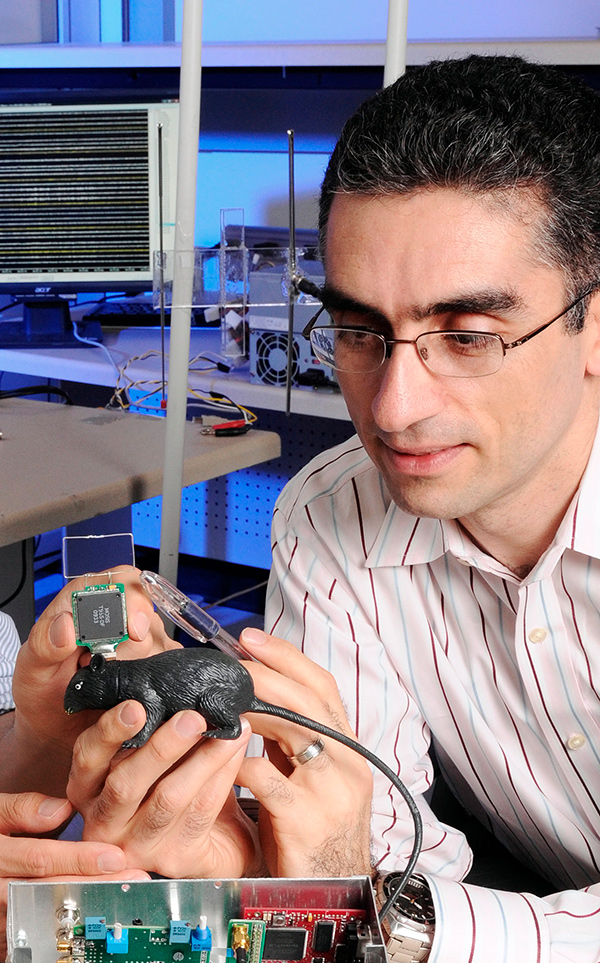
Gary Meek/Georgia Tech
The best research often relies on observing animals in the least artificial environment possible. Maysam Ghovanloo, an associate professor in Georgia Tech's School of Electrical and Computer Engineering, has developed a wireless system that collects neural signals from alert, freely moving rats during experiments. "This removes the need to tether a small animal via cable to a neural recording device . . . and relieves the animal from carrying bulky batteries, thus eliminating two major sources of motion artifacts and bias," says Ghovanloo. The mobile unit also contains a small magnet that allows the animal's location to be tracked in real time. Ghovanloo is collaborating with Joseph Manns, an assistant professor in Emory's Department of Psychology, to test the system.
Electric Slide
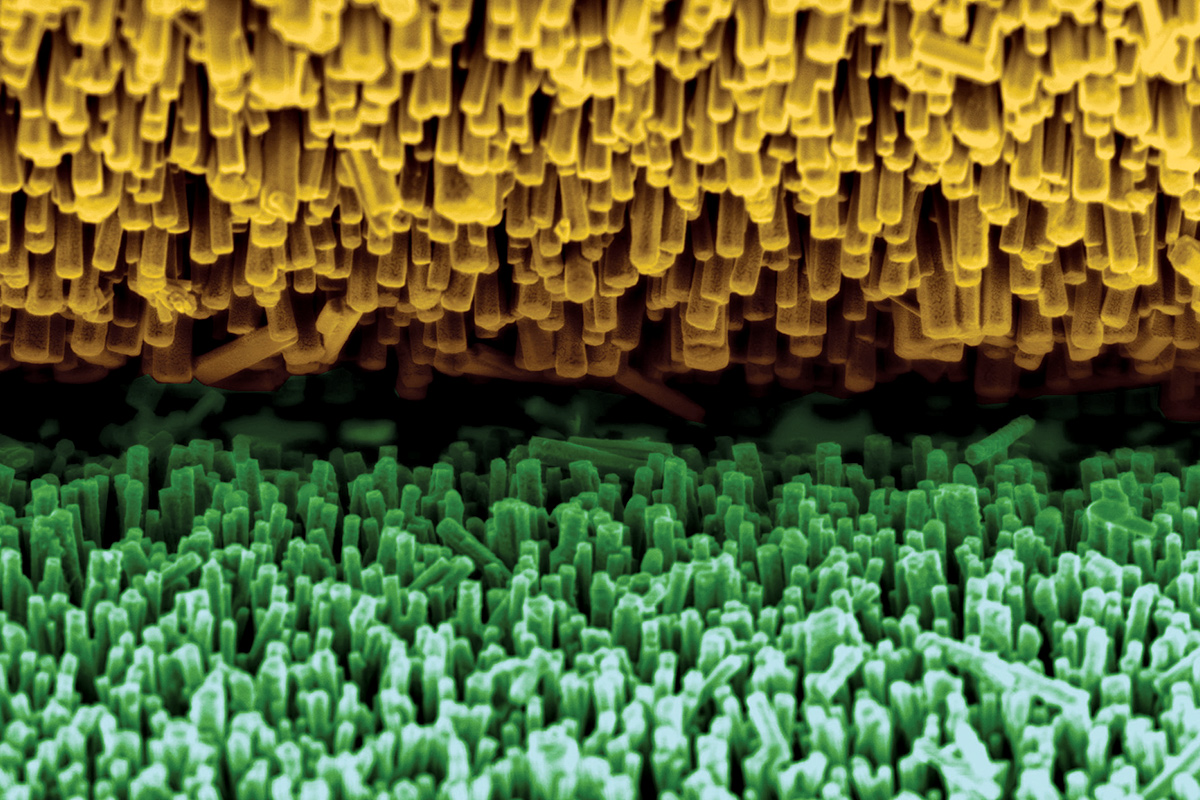
Courtesy Zhong Lin Wang and Xudong Wang
Imagine wearing a T-shirt that could power your cell phone. Textile fibers covered with zinc oxide nanowires can generate electrical current, and combining current flow from many fiber pairs woven into a shirt or jacket could allow the wearer's movement to power small electronic devices. "The fiber-based nanogenerator would be a simple and economical way to harvest energy from physical movement," says Zhong Lin Wang of the School of Materials Science and Engineering at Georgia Tech. "If we can combine many of these fibers in double or triple layers in clothing, we could provide a flexible, foldable, and wearable power source that, for example, would allow people to generate their own electrical current while walking." The research was sponsored in part by the joint Nanotechnology Center for Personalized and Predictive Oncology.
Child-Sized Dialysis
When critically ill children need kidney dialysis, doctors have to adapt adult-size equipment, because there is no FDA-approved continuous bedside dialysis device for children. But these devices can withdraw too much fluid, leading to dehydration, shock, and loss of blood pressure. Researchers from Emory and Georgia Tech have developed smaller equipment especially for pediatric patients. "We have built a robust device that achieves automated and accurate fluid management," says Ajit Yoganathan, Coulter Distinguished Faculty Chair in Biomedical Engineering, who worked with Matthew Paden, Emory assistant professor of pediatric critical care.
Big Data and Brave Hearts
Heart attacks are rare among children, but not unheard of. So how do you tell which child complaining of chest pain is actually in crisis? Professor of Interactive Computing Mark Braunstein, associate director of the Health Systems Institute, an interdisciplinary initiative based at Georgia Tech and Emory, asked Georgia Tech Professor of Computational Science and Engineering Hongyuan Zha for help in determining which young patients need further medical tests, such as echocardiograms and stress tests. With pediatric cardiologist Patrick Frias, chief of Children's Healthcare of Atlanta's Physician Group, Zha is analyzing a year of records from Children's Sibley Heart Center, looking at patient and family history questionnaires, diagnostic tests, and final diagnoses of young patients at Sibley who complained of chest pains. "One year of these records contains close to twenty thousand cases, which is a very extensive data set," Zha said. "By going through the historical data, we hope to come up with some rules or best practices that are more efficient than the existing ones."

Michelle LaPlaca, right
Nicole Cappello/Georgia Tech
Immediate Gratification
After observing a fellow passenger on a flight wearing noise-canceling headphones, Emory Associate Professor of Emergency Medicine and director of Emergency Neurosciences David Wright imagined a better way to test for concussions. "The problem with concussions and sports is there's really no good way to evaluate someone on the sidelines," says Wright, a specialist in traumatic brain injury. "It requires hours in a quiet room with a trained examiner." Likewise, tests to detect mild cognitive impairment (early dementia) in aging patients are usually conducted with pen and paper, last more than an hour, and require a quiet place to concentrate. But Coulter Associate Professor Michelle LaPlaca and Wright developed a portable, head-mounted screening device called DETECT that can identify concussions or impairment with a ten-minute battery of visual stimuli and can be given anywhere. A clinical study at Emory's Wesley Woods Center showed that DETECT had similar accuracy to that of a written test. The technology is currently being used by four football teams and development for military application is underway.




